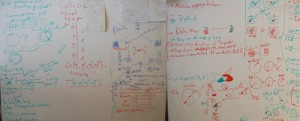A user’s guide to tech WIP
∴ medium
This project began from the idea of using Youtube tutorials as a communicative medium.
I have always enjoyed e-learning (Youtube, Codecademy, Khan Academy, misc articles). In an e-learning environment, you are not just a learner but also a user. As a user, you are in control of the content’s speed. Especially as content becomes more complex, going at your own pace can make all the difference. Also as a user, the experience is unique as you are not expected to do anything other than simply watch, read, or follow along. At the end however, you are no longer just a user. You have gained a skill, which gives you the ability to build, develop, create…for other users. Therefore in this mode of learning, teacher merges with student.
Most often, the front-end experience of a tutorial demonstrates how things are working from the back-end:

∴ content
So from this interest I started with what content I wanted to communicate, which happened to be an outline of ‘valuable things I had learned’ (or as I really like to call them, ‘some superpowers I have gained’) by transition from tech user to tech creator:
- Becoming invisible — how encryption works
- Browsing without fear — how ad blockers work + when to use them
- Reclaiming sense of self — how to spot bots + how they work
- Reversing mistakes — how version control works
- Owning nothing — degrees of deletion
- Coming back to reality — exercises for routine computer usage
As we appear to be in an era where the daily objects we use are hard to figure out from the outside, we begin to ask questions similar to critical designer Isabel Mager:
“Why am I so familiar with these devices, yet so unfamiliar with their making?”
(Isabel Mager, “5000times exploitative mechanisms within the design of smart high-tech products“)
Interestingly enough, because most of us are such advanced users, using technology as a medium to teach it makes sense.
Now what becomes important here is how the content is crafted and presented. This depends on a few things:
- audience: artists, designers, users of technology. ages 5th grade – adult
- length of time: 1 — 7 mins
∴ inspiration
The final step is presenting and crafting the tutorials. How do you start?
First I research everything I can about the tutorial’s topic, including other tutorials. This is a crucial step, as you are essentially reenacting what the user would have to do to learn about the topic the hard way.
Once you get a more detailed understanding of the topic, you are able to build a stronger narrative. I say narrative because the information will be presented across a linear amount of time, so it helps to order, group, and simplify — ideally trying not to jump around.
Lesson Plan structure
Looking at sample lesson plans was helpful by developing a structure for how a concept is unpacked. List materials, go step-by-step through activities breaking down the topic at hand.
Brit Cruise
Brit Cruise is a Youtube tutorial master. He uses a lot of history to explain massive concepts stemming from Applied Math like What is a Computer? or How does Information Technology or Cryptology work? What is Logic?
He always starts his videos with a physical analogy – making sure to make everything as clear as possible, assuming he knows nothing. He bounces the idea around with people he knows, like his wife and musician/history buff friend. He eventually sketches out the idea and breaks the sketches down into separate videos, resulting in a 2 hour long series.
He uses a lot of CG animations and simulations, often collaborating with different artists and volunteers.
In an interview, he talks about his process further, often relating everything to physical analogies:
“Anyway, then I’ll record a narration for a video, usually semi-improvised off a point form list I make at the end. Trying to pretend I’m at a dinner table with one person.
CUP – The Internet is Serious Business (13:11 – 14:43)
Vi Hart
Vi Hart is a Youtube tutorial master. This was the first video I’ve seen of hers. I found a video about how she makes her videos, which gave me SO MANY tips:
Script first. Write succinctly.
If you can visualize stuff, you don’t need to say it. and visa versa.
Voiceover narration last. Match up with the visuals.
Heavy editing!
Crashbox

